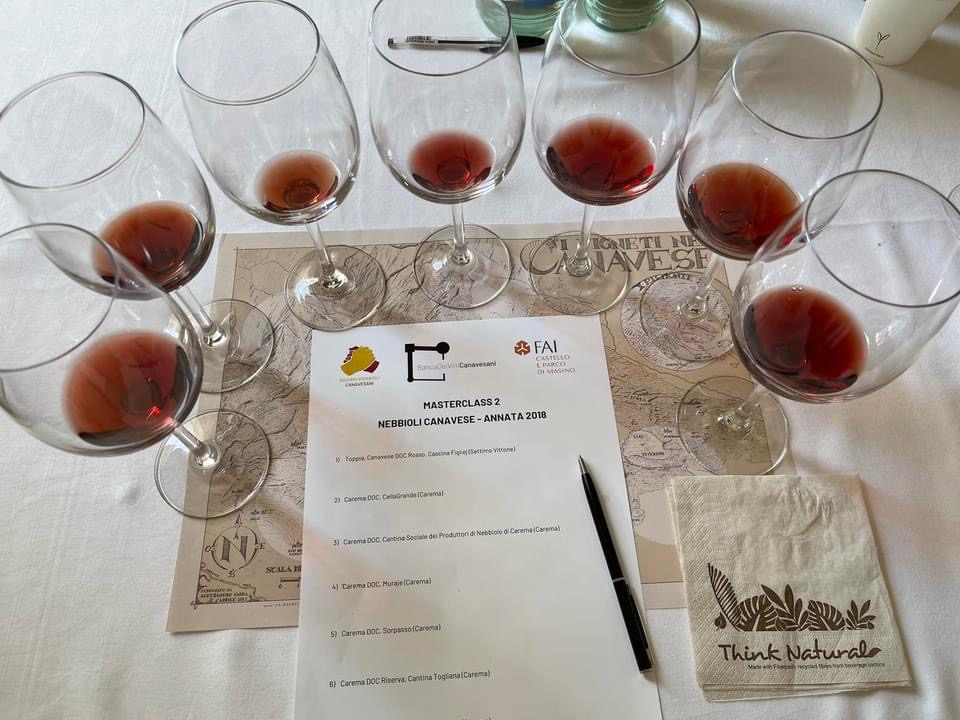This website uses cookies so that we can provide you with the best user experience possible. Cookie information is stored in your browser and performs functions such as recognising you when you return to our website and helping our team to understand which sections of the website you find most interesting and useful.
Exciting new wave of young vignerons emerge in Canavese
A new wave of young winemakers in the Canavese wine region in Piedmont on the border with the Aosta Valley are bringing great energy to small region and making some fantastic wines of note. Filippo Bartolotta investigates…
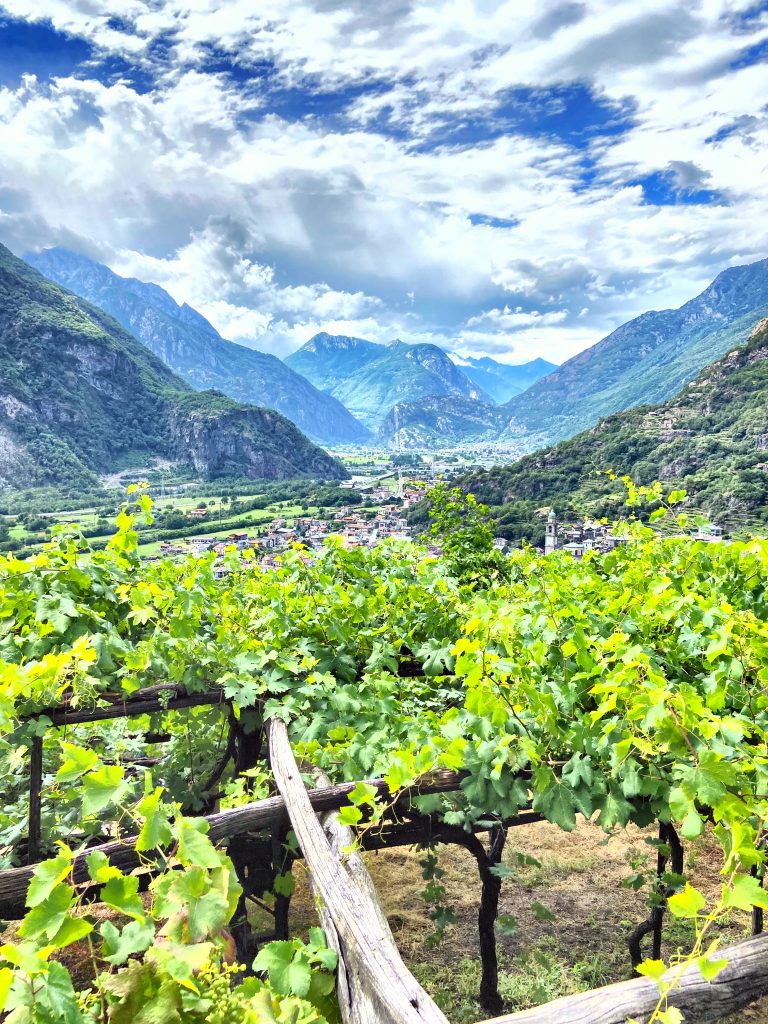
Canavese is a wine-growing area in Piedmont on the border with the Aosta Valley. It is the home of the zesty and mineral white variety, Erbaluce di Caluso DOCG, the super-refined Nebbiolo based Carema DOC and Canavese DOC.
It is a mountain wine appellation with vineyards climbing to the extreme inclinations possible thanks to the ingenious dry-wall terraces and scenic Pergola trellises.
Why am I reporting on Canavese? Because I fell in love with the truly heroic gestures of the vigneron who must do anything and everything by hand, facing the toughest natural adversities, which includes the detachment of massive stones from the mountain while pruning.
I fell in love with Canavese because the wines are a pure and transparent representation of where they come from showing exactly their provenance with a mineral, hyper-juicy and intense character and yet very fragile and delicate.
Another reason to get to know more about this area is the chance to enjoy that wonderful sense of discovery and reward of a hidden secret, kept away from the spotlights and therefore also with really high value for money.
Naturally, Canavese’s winemakers are seeking the attention that they deserve fully. People have been making wine here for centuries, but the success of the textile industry in Biella and that one of the world pioneer typewriter company Olivetti – one of the economic miracles of the 1950’s – resulted in a contraction of the vineyards. For example, at the start of the 20th century Carema had around 120ha of vineyards, but today that area is down to 22 hectares. (The total 478 ha of the area is split between Caluso DOCG (263ha), Canavese (165ha) and Carema (22ha)).
But although this seems, and is a small size, a counter-trend has been growing over the few years. If we looked back only ten years ago, Carema DOC was only 13 hectares, so what is happening to prompt this growth?
It is the rise of a new wave of winemakers: 22 young vigneron of Canavese.
Rejuvenation
We are talking about a group of highly motivated producers under the age of 40 who have taken over some beautiful old vines, or simply started planting new ones on the cliffs of the mountains. The majority of them bottled for the first time only two or three years ago but thanks to the solid comradeship of this group the results in the glass are really exciting.
The area looks like a butterfly with one wing on the mountain on the west side of the Dora Baltea river, home of Carema DOC and the other wing on the east side, home of Erbaluce di Caluso Docg while Canavese DOC can be on both sides.
The ‘butterfly’ is actually a natural amphitheatre created between 900,000 -10,000 years ago by the debris brought by the melting of a glacier. The Dora Baltea amphitheatre is the only one in Europe that originated by travelling through all the tectonic plates of the Alps, and as a result, the soil consists mainly of sand, stones and pebbles extremely rich in minerals.
We are one and a half hour drive north of Barolo. The grape verity is the same Nebbiolo which here is called Picotendro, a Lampia sub-variety, according to a brilliant masterclass held in Ivrea recently by Armando Castagno.
Nebbiolo must be at least 85% and when the wines are not vinified pure then the remaining 15% can be Pugnet and Ner d’Ala.
The minimum age is 24 months for the Annata and 36 months for the Riserva. Both wines must spend a minimum 12 months in oak.
So are these complementary varieties what make Carema wines so different from the most famous Barolo and Barbaresco? Not really. These varieties are very neutral ones and of course they could add complexity to the blend, but the main factors I believe are the combination of the sandy soil and the mountain conditions: the forts bringing a sort of sweet touch on the palate while the latter adding verticality and juiciness to the wines.
The vineyards climb up at an incredible 72% inclination under very steep mountains: the Bec Renon and Bec di Nona going over 2000m above sea level, are only 5km away from the Dora Baltea and this generates a drastic temperature drop during the night.
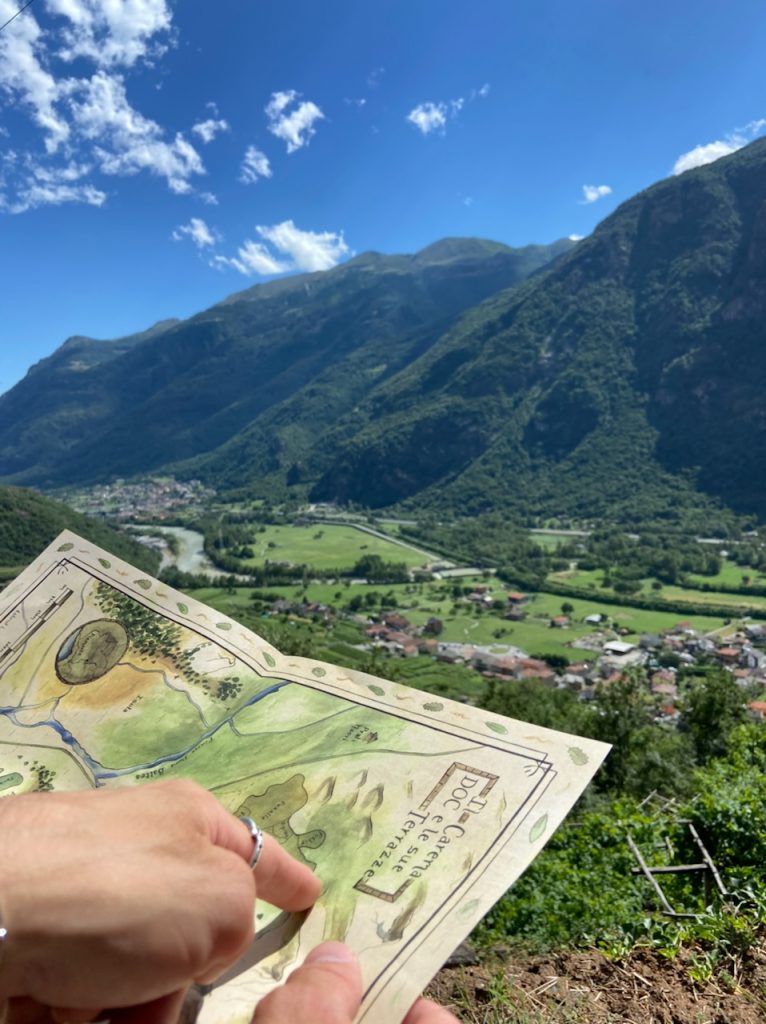
While exploring the region with local sommelier and passionate tour guide Lorenzo Labriot, we struggled a couple of time to get the minivan up the hills. So while Armando and I were excited but a little frightened by the mesmerizing roads escalating the Alps, Lorenzo seems perfectly at ease, despite the wheels of the minivan squeaking and smoking struggling to go up.
Once we stop right close to one of the highest vineyards of Carema at 600m above sea level, Lorenzo grabbed a brand new map of the area he contributed to design and showed us the ancient Pergola system built with only with the local oak and chestnut wood.
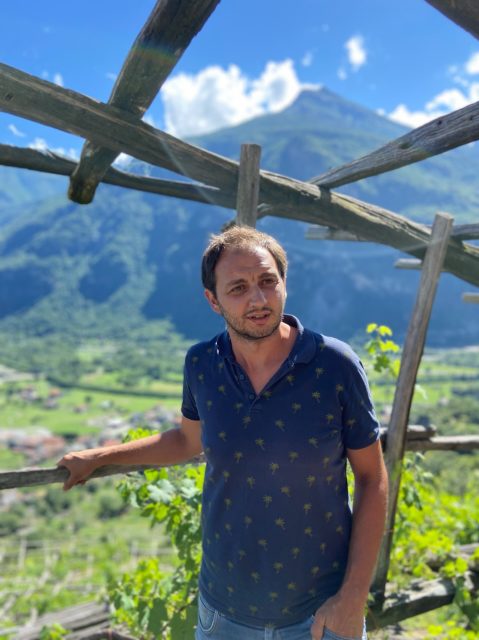
“The name of this structure is ‘topia’,” explained Gianmarco Viano one of the founders of the Giovani Viticolotri del Canavese. “The wooden architecture is built on stone pillars or ‘pilun’, over the terraces and degrading downhill for a few metres. Given that there is not much available land, the topia not only protects the berries from the summer sun or the hail storms but it also increases the amount of (virtual) hectares.”
Basically it’s like having a ground floor and a first floor of vines on the trellis.
The proximity to the mountains is everything to this region: homes, cellars, castles and restaurants are built right next to the mountains. And during the recent scalding hot summers, enjoying a wine tasting in their ‘balmetti’ (17th century cellars) is like heaven as the ‘ore‘ (the air currents coming from the mountains) make a constant temperature of around 11°C.
But like everything there’s also the other side of the coin, Vittorio Garda, the President of the young producers’ association explains.
“We owe everything to these mountains but they also represents our limits,” he said, pointing out the Bec Renin on the other side of the Bec di Nona, where we sip wines. I say it’s beautiful and he says “Yes – but that is also how far the horizon, the mental horizon, here can be – very short! But this is what we have to do, widen our horizons.”
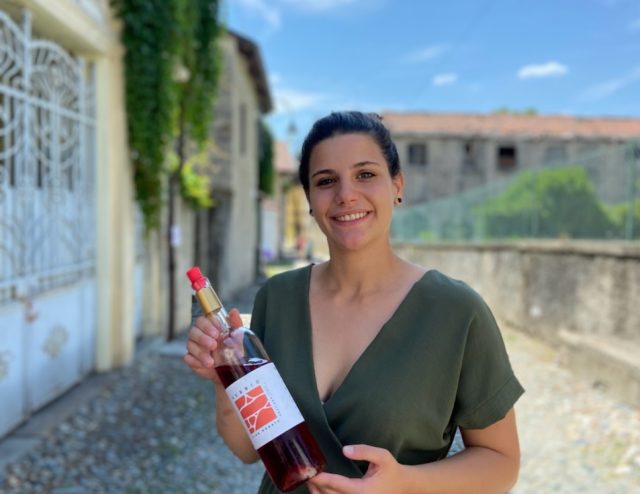
I am convinced that this is already happening. For example Giulia Aloi, (pictured) is one of the most motivated producers I’ve met, despite being only 26 years old, while the youngest, Marco Trovero, is only 24. Bearing in mind the small size of these wineries – some of these vineyards are only 0.25ha – they nevertheless seem to be having a big impact.
During the most recent promotional event, Re-Wine 2022, the tasting events were always full and some of the historical wineries, such as Produttori di Carema, are enjoying the bright new energy this energetic group is bringing to the region.
This year, for example saw the birth of a potential new and ambitious project regarding the definition of 43 crus which Castagno has mapped thoroughly (with the help of Lorenzo Labriot, Gianmarco Viano, Vittorio Garda and Achille Milanesio). And although this isn’t an official step yet, it is the embryo of a possible Carema MGA.
What to expect
So what are the expectations when cracking open a bottle of wine from this northern western most side of Piemonte, where it borders Valle d’Aosta?
The Erbaluce di Caluso Docg shows some really refreshing citrus fruit and mineral driven wines with a creamy acidity -like a great Riesling Kabinet- and great longevity.
The reds are showing always a very transparent light red ruby color with the classic garnet hues (typical of any great Nebbiolo). Plenty of red fruit with pomegranate acidity, some mountain verticality but with a sweet and caressing touch and an extraordinary aging potential. Throughout the years I have had the chance to open some seriously smashing bottles of Carema from the 1950’s and 1960’s in a state of grace. I can still remember a bottle of Ferrando Etichetta 1962, a Produttori di Carema 1985 and during this trip, I was able to taste a bottle of Achille Milanesio Carema 1989 – both wonderful examples of the pedigree of this region, that I suggest any wine lover should keep their eyes peeled for.
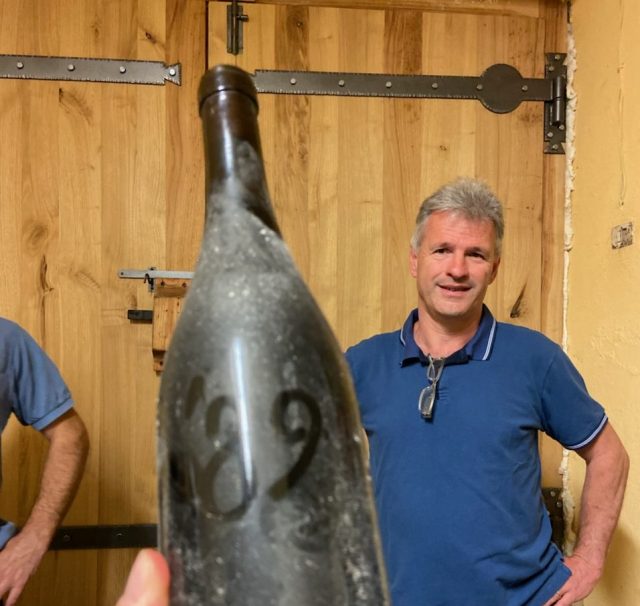
Tasting notes
Seven Erbaluce di Caluso DoCG, 2018
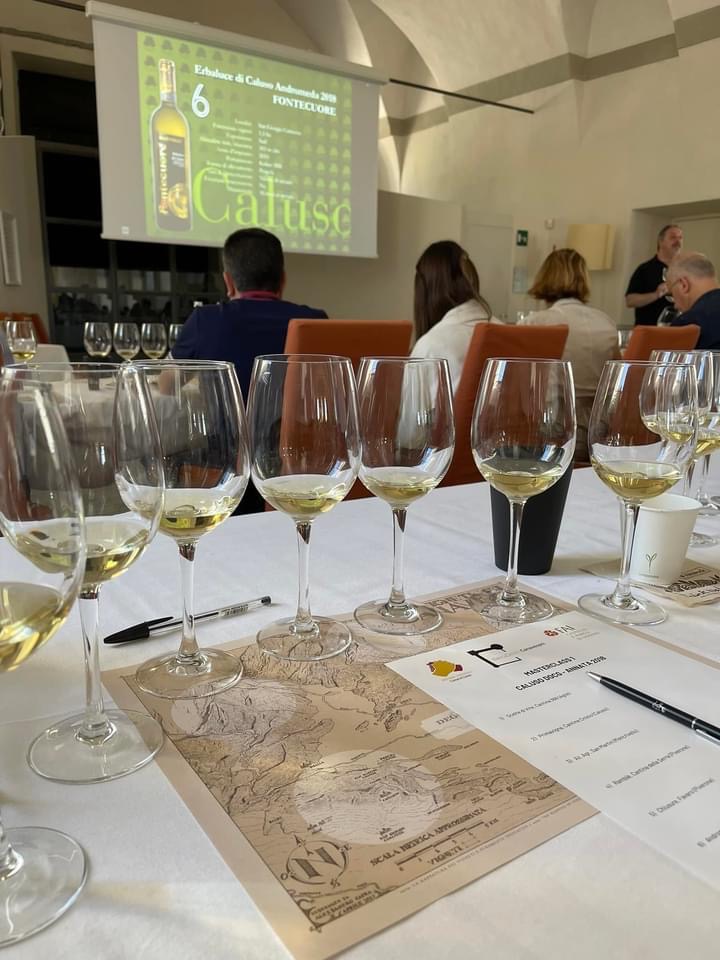
1. Scelte di Vite, Cantine 366 (Agliè)
(A 2 Ha vineyard, 300m above sea level south exposed. Inox fermented and aged for a few months). Very creamy and mineral with some lemons, hay and a stone fruit edge. Creamy palate with a good acidity and a very reactive citrus driven fruit and a really pleasant hot finish but very lingering. A light and refreshing white relatively simple white with a vey pleasant mouthful.
2. Primavigna, Cantine Crosio (Caluso)
(Four south exposed hectares 350m above sea level. Fermented in inox with 40% of malolactic fermentation done). Lovely ripe lemon and white peaches. An intriguing smoky nose with some dry herbs. Elegant with mango aromas, herbal and a very intense ripe and sweet finish with a floral touch.
3. Az. Agr. San Martin (Moncrivello)
(An organic driven 1.3ha winery 350m asl all inox fined) A darker golden color showing also a riper fruit on the nose and an almost tannic palate. Some green herbal charcter and a bitter almond and hezelnuts finish.
4. Ramblè, Cantina della serra. VIgneto Cariola(Piverone)
(On the far east of the Erbaluce appellation, almost touching the Serra di Ivrea. 2ha old vines planted in 1975) Amazing freshness and suppleness. Sweet fruit, salty bites, lovely stone fruit. An intense almond and anice flavor. Rielsing style with so much acidity and sweet fruit but with no residual sugar. Crunchy white with so much sapidity and a lovely citrus and mountain flowers finish. 92/100 Drink now-15
5. Chiusure, Favaro (Piverone)
(2.5ha organic farm 380m asl. 24 hours of pre-fermetative maceration and inox only finding) Hazelnuts, aniseed, wild fennel. Juicy, mineral. Impossible to spit it! Plenty of character. Exotic fruit with an inner strength and a crazy minerality. Very long finish. 95/100 Drinks Now-25
6. Andromeda, Fonecuore San Giorgio
(1.5 ha 365 m asl. 16 months finning in inox vats. From a very poor soil, hence a very productive rootstock like Kober5BB). Herbaceous style, very balsamic. Wild fennels, walnut and almonds. A very structured white with a good length and a very important personality.
7. Misobolo, Cieck (San Giorgio)
(From the south east side of the appellation and early 1970’s vineyards) Definitely the most structured of the tasting with so much extractives combined with a very round and velvet touch though. Pineapple and grapefruit all around a beautiful pine sap, Mediterranean herbs and an extremely sweet, voluminous finish, from the fruit maturity rather than residual sugar. 93/100 drinks now/20
Eight red wines from Canavese 2018
1. Toppia, Canavese Doc Rosso, Cascina Figlie
(Vineyards planted in 1920 in the southwest side of the appellation. Fermented in oak vats with 60 days of maceration). The wine shows a very bright and transparent color. Strawberry jam, iron and dry roses. Sweet red fruit with some bitter orange marmalade. A little astringent at the beginning with a crunchy wild berries finish. 91/100 drinks now/20.
2. Carema Doc, CellaGrande (Carema)
(A very small vineyard of 0,7ha from one of the most modern winery in the region). The wine is very well made with a red ruby and garnet hues showing a great deal of red fruit, some dry flowers a lovely crunchy plate and a some mountain dry herbs. A very nice and relatively easy to understand Carema. 89/100 drinks now/15.
3. Carema Doc, Cantina Sociale dei Produttori di Nebbiolo di Carema (Carema)
(A staggering (for the appellation) 14.5 ha around 300-500m asl. Some of the vines are 80 years old. Fermented in cement and inox vats for 28 days with 24 mesi months of barrel aging). Roses, red fruit with a lovely and reactive mouthfeel and a lot of balsamic perfumes. Almost salty with so much juiciness Splendid officinal herbs together with strawberries on a delicate mineral palate. Licorice and slightly smoky. Benchmark wine with blend from different plots and so delicious. 96/100 drinks now and age forever.
4. Carema Doc, Sumiè Muraje (Carema)
(The name ‘Sumiè’ comes from the oak beams of the Carema trellis. A blend from different vines from a total 0,42Ha at 400m above sea level. Cement vat wild yeast fermentation with 50 days of maceration and 18 months of tonneaux) Federico Santini produced his first vintage in 2017. This second attempt is a relatively extractive style for the appellation but nonetheless always played around buckets full of red fruit and a mineral finish. Structure, power not always under control but with a great character. 92/100. Drinks now/20.
5. Carema Doc, Sorpasso (Carema)
(0,8 ha of old vineyards – some dating to the 1930’s – from one of the most spectacular valleys in Carema. Over 60 days of maceration, with 18 months of barrel aging, in tonneaux and barrique second passage). Martina and Vittorio Garda have been crafting a wonderful red fruit driven wine with so much minerality but above all extremely juicy and refreshing. Raspberries, liquorice, super salty and crunchy. 94/100 drinks now-30.
6. Carema Doc Riserva, Cantina Togliana (Carema)
(0,60 ha of 1970’s vines at 350m above sea level. Inox fermented with 12 months in Slavonian 10hl barrels.) Pomegranate, redcurrant and goji berries with some medlar fruit style tannins. On the palate is a strawberries feast with some balsamic and iodine touch. A touch floral with a very intense iron and earthy palate. Needs time. 93/100 Drinks 5/35.
7. La Costa, Carema Doc, Monte Maletto
(0,07ha vine, which is the equivalent to a single barrique! 35 days of maceration and 20 months of barrique. 100% whole bunch fermentation with stalks. Gian Marco Viano has produced 3 magnums only and we drank two of the stash). Incense and smoky nose with roses, sour cherries and rose-hips. Very firm tannins with an orange zest and some sweet liquorice. This is the first vintage and the outcome is stunning. It is actually a wine to wait with a strong character. 93/100 drinks 5/35.
8. Giovanetto Canavese Nebbiolo 2018
I can’t believe the energy of this wine. A mind blowing Nebbiolo with anything one wants to look for a great fine red including a complexity of aromas, in this case wild berries, wisteria, sweet roots, echinacea and so many mountain strawberries. What I mostly love about this wine is the contrasted salty palate, the abundance of red berry crush which makes it so easy to love and understand and a refined palate with a really long finish. 96/100 drinks now/40.

